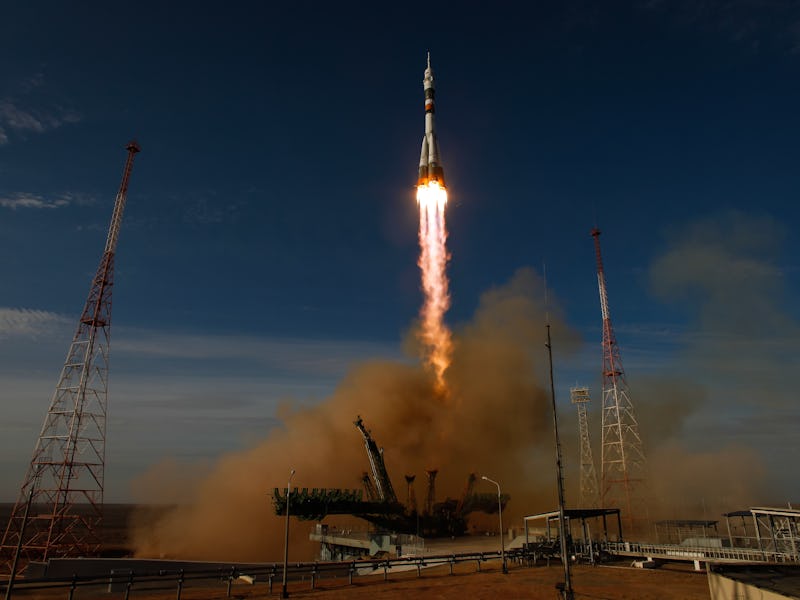One of NASA's Biggest Concerns Comes to Light in Cleveland
Seems like SpaceX is leading the way to take U.S. astronauts to the ISS.

One of the biggest concerns for NASA is that it won’t be able to send U.S. astronauts into space after 2018.
On Thursday, the NASA Advisory Council held a public meeting at the Ohio Aerospace Institute in Cleveland to deliver a series of reports about the status of the agency, and offered an update on Human Exploration and Operations. Basically, time is running out for the space agency to find another way to get American astronauts to space.
America needs to let the Russians know if it’s hitching a ride aboard the Soyuz spacecraft before the year is out, or else we may see a temporary — or worst case scenario, permanent — end of a U.S. presence aboard the International Space Station.
Since the Space Shuttle program was shuttered in 2011, NASA has had to buy seats on Soyuz rockets in order to send its astronauts to the ISS. It’s never been an ideal partnership. Russia recently announced it had no intention of drafting up a new launch contract with the United States after the current one expires on December 31, 2018. The U.S. government has been eager to see the country’s space program regain its independence, anyway.
Right now, NASA’s working overtime to get the Space Launch System ready for an inaugural 2018 launch, but SLS is a heavy-duty system designed for deep space missions — it’s not really something made for regular low Earth orbit operations like trips to the ISS.
SpaceX's Falcon 9 rocket makes a successful launch with the SES-9 communications satellite on March 4, 2016 in Cape Canaveral, Florida.
The solution? Presently, it’s to work with commercial spaceflight companies like SpaceX and Boeing after 2018, while NASA continues development of the Space Launch System, which should have its first launch in November 2018.
This would not only keep crewed space launches within the United States once again, but also be a major step in the larger effort to turn low Earth orbit operations over to the private sector. NASA is currently working with SpaceX and Boeing to develop viable orbital launch transportation systems for humans and test launch them. According to NASA, both companies are making progress — SpaceX is expected to be certified for a crewed test flight by October 2017, and Boeing by May 2018.
However, it’s entirely possible either or both companies could miss those deadlines and not be ready to send humans to the ISS before the end of 2018.
The Soyuz TMA-19M rocket.
This would put NASA in a pretty big jam. The agency has to buy seats on Soyuz launches about three years in advance. As put bluntly by Wayne Hale, a former NASA engineer and current interim chair of the HEO Committee, “there’s not a plan for NASA to purchase Soyuz seats after 2018.”
The committee report’s findings state: “Due to long lead time required to procure Soyuz seats, a decision must be made by the end of [2016] to guarantee access to ISS in [2019], or NASA may be forced to reduce — or possibly eliminate its crew complement aboard ISS.”
Should we be concerned? As mentioned, both companies are on track to meet the given milestones, but nevertheless, the HEO report finds that it is “prudent to assume day delays in post-certification missions from today’s schedule.” It wouldn’t be unusual to see either company run into snags. In fact, when you take into account SpaceX’s failures in the last year or so, it’s almost likely there’ll be some sort of delay.
So why hasn’t NASA created a backup plan? Hale, never one to mince words, put it in succinct terms: “we don’t know what the solution would be.”
This artist concept depicts the Space Launch System rocket rolling out of the Vehicle Assembly Building at NASA's Kennedy Space Center. SLS will be the most powerful rocket ever built and will launch the agency’s Orion spacecraft into a new era of exploration.
One possible resort would be to simply negotiate and bargain with Russia until they acquiesce and offer a seat or two on a future Soyuz launch. Perhaps that’ll be easier if a certain Republican ends up winning the presidency this November — but who knows what that might do to the rest of the space program.
Hopefully we don’t even come close to a situation like that. NASA has until the end of the year to figure out if it wants to purchase more Soyuz seats or not.